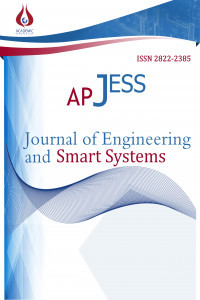Engelli Karıştırmalı Tanklarda Karıştırıcı Hızı Değişiminin Pickering Emülsiyonlarının Damlacık Boyut Dağılımı Üzerine Etkisi
Pickering emülsiyonu, sıvı-sıvı karıştırma, karıştırmalı tank, damlacık birleşimi, emülsifikasyon
The Effect of the Change of Impeller Speed on the Droplet Size Distribution of Pickering Emulsions in a Baffled Stirred Tank
Pickering emulsions, liquid-liquid mixing, stirred tank, droplet coalescence, emulsification,
___
- [1] Chen, G., & Tao, D. (2005). An experimental study of stability of oil–water emulsion. Fuel Processing Technology, 86(5), 499-508. doi:10.1016/j.fuproc.2004.03.010
- [2] Pickering, S.U., 1907. Emulsions. J. Chem. Soc. 91, 2001.
- [3] Binks, B. P. (2002). Particles as surfactants - Similarities and differences. Current Opinion in Colloid and Interface Science, 7(1–2), 21–41. http://doi.org/10.1016/S1359-0294(02)00008-0
- [4] Binks, B. P., & Lumsdon, S. O. (2000). Influence of particle wettability on the type and stability of surfactant-free emulsions. Langmuir, 16(23), 8622–8631. http://doi.org/10.1021/la000189s
- [5] Binks, B. P., & Lumsdon, S. O. (2001). Pickering emulsions stabilized by monodisperse latex particles: Effects of particle size. Langmuir, 17(15), 4540–4547. http://doi.org/10.1021/la0103822
- [6] Aveyard, R., Binks, B. P., & Clint, J. H. (2003). Emulsions stabilised solely by colloidal particles. Advances in Colloid and Interface Science, 100–102(SUPPL.), 503–546. http://doi.org/10.1016/S0001-8686(02)00069-6
- [7] Tsabet, È., & Fradette, L. (2015). Effect of the properties of oil, particles, and water on the production of Pickering emulsions. Chemical Engineering Research and Design, 97(1), 9–17. http://doi.org/10.1016/j.cherd.2015.02.016
- [8] Arditty, S., Whitby, C. P., Binks, B. P., Schmitt, V., & Leal-Calderon, F. (2003). Some general features of limited coalescence in solid-stabilized emulsions. European Physical Journal E, 11(3), 273–281. http://doi.org/10.1140/epje/i2003-10018-6
- [9] Madivala, B., Vandebril, S., Fransaer, J., & Vermant, J. (2009). Exploiting particle shape in solid stabilized emulsions. Soft Matter, 5(8), 1717. doi:10.1039/b816680c
- [10] Kaptay, G. (2006). On the equation of the maximum capillary pressure induced by solid particles to stabilize emulsions and foams and on the emulsion stability diagrams, 283, 387–401. http://doi.org/10.1016/j.colsurfa.2005.12.021
- [11] Walstra, P. (1993). Principles of emulsion formation. Chemical Engineering Science, 48(2), 333–349. http://doi.org/10.1016/0009-2509(93)80021-H
- [12] Leng, D. E., & Calabrese, R. V. (2004). Immiscible Liquid – Liquid Systems. Handbook of Industrial Mixing: Science and Practice
- [13] Zhou, G., & Kresta, S. M. (1998). Evolution of drop size distribution in liquid-liquid dispersions for various impellers. Chemical Engineering Science, 53(11), 2099–2113. http://doi.org/10.1016/S0009-2509(97)00437-5
- [14] Siddiqui, S. W., & Norton, I. T. (2012). Oil-in-water emulsification using confined impinging jets. Journal of Colloid and Interface Science, 377(1), 213–221. http://doi.org/10.1016/j.jcis.2012.03.062
- [15] Hemrajani, R., & Tatterson, G. (2004). Mechanically Stirred Vessels. Handbook of Industrial Mixing: Science and Practice. http://doi.org/10.1002/0471451452.ch6
- [16] Wichterle, K. (1995). Drop breakup by impellers. Chemical Engineering Science, 50(22), 3581–3586. http://doi.org/10.1016/0009-2509(95)00208-M
- [17] Skelland, A. H. P., & Kanel, J. S. (1990). Minimum Impeller Speeds for Complete Dispersion of Non-Newtonian Liquid-Liquid Systems in Baffled Vessels. Industrial and Engineering Chemistry Research, 29(7), 1300–1306. http://doi.org/10.1021/ie00103a032
- [18] Bhattacharya, S., Hebert, D., & Kresta, S. M. (2007). Air entrainment in baffled stirred tanks. Chemical Engineering Research and Design, 85(5 A), 654–664. http://doi.org/10.1205/cherd06184
- [19] Rawle, A. (1993). Basic principles of particle size analysis, 44(0), 1–8. http://doi.org/10.1016/j.apgeochem.2015.02.008
- [20] Cabaret, F., Bonnot, S., Fradette, L., & Tanguy, P. A. (2007). Mixing Time Analysis Using Colorimetric Methods and Image Processing. Industrial & Engineering Chemistry Research, 46(14), 5032–5042. http://doi.org/10.1021/ie0613265
- [21] Tolosa, L. I., Forgiarini, A., Moreno, P., & Salager, J. L. (2006). Combined effects of formulation and stirring on emulsion drop size in the vicinity of three-phase behavior of surfactant-oil water systems. Industrial and Engineering Chemistry Research, 45(11), 3810–3814. http://doi.org/10.1021/ie060102j
- Yayın Aralığı: Yılda 3 Sayı
- Başlangıç: 2022
- Yayıncı: Akademik Perspektif Derneği
Hanife PALABIYIK, İbrahim ÇİL, Merve CENGİZ TOKLU
Cihat ŞEKER, Muhammet Tahir GUNESER
Bira Endüstrisi Atıksularının Elektrokoagülasyon ile Arıtımı ve Hibrit Elektrot Bağlantısının Etkisi
Determination of Ceramic Cutting Tool Performance on Machining of Steel (PMD23) Produced by Powder
Nöropazarlama Uygulamalarında Ürün Grubu ve Sektör Seçimi
Mahmut PAKSOY, Gökhan KARARSIZ, Muzaffer METİN
Toz Metalurjisi Yöntemiyle Mg-Sn Alaşımı Üretimi ve Karakterizasyonu
